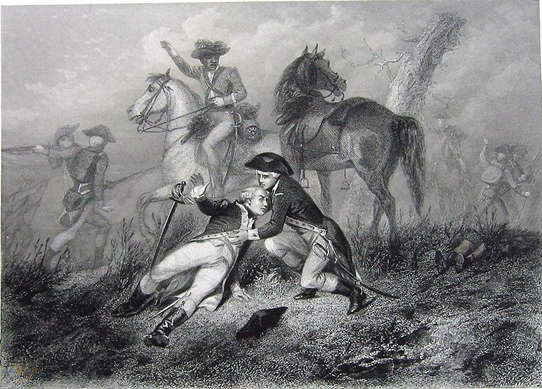Lafayette and the Battle of Brandywine

Several years ago we visited friends in Wilmington, Delaware, a beautiful part of our country and steeped in DuPont history. Longwood Gardens is an overwhelming site you should not miss if you are in the area. A short distance over the line into Pennsylvania south of Philadelphia everything seems to be named Brandywine-something. I now regret this, but it failed to register with me that here was a historical site of an important Revolutionary War battle. And the Marquis de Lafayette was there.
Lafayette had just arrived in America on June 13, 1777, near Georgetown, South Carolina, having sailed on the ship Cadmus at his own expense. He was eager to join the fight for liberty and separation from the Crown. In no time he had been given a commission as a Major General by the Continental Congress and he provided money for badly needed supplies. He became an aide to General George Washington. They immediately liked each other and became very close. The nineteen-year-old Marquis had lost his father when he was two, and Washington had no children. It became a father-son type bond. Lafayette was becoming proficient in English, and despite his title and association with the military in France, he had no battle experience and little training. But he lacked no enthusiasm for the cause. His first chance came in September at Brandywine Farm.
The British goal was to capture Philadelphia, our capital. British General Howe sailed from Sandy Hook New Jersey with tightly-packed troops aboard his 260-boat Armada on July 23rd and turned up the Chesapeake Bay, surprising Washington by landing at Head of Elk, Maryland, south of Philadelphia on August 25th. The British forces took time to recover from the voyage and illness and numbered about 15,500. The colonists awaiting were about 14,600. The two sides encamped and prepared for a major battle. Washington’s headquarters was at Benjamin Ring’s house and Lafayette was housed at Gideon Gilpin’s farmhouse . The fighting began on September 11th. Brandywine became the longest battle in the War. Fighting continued non-stop for 13 hours. General Howe had out-maneuvered the young Americans, using local information from Quakers who were sympathetic to the Tory cause. Hessian Lieutenant-General Knyphaussen attacked head-on at Chad’s Ford and this was the diversion; Howe and Cornwallis went further up the Brandywine and crossed at Jeffries Ford which was not included in Washington’s incomplete intelligence information. This allowed Howe’s men to surprise Washington’s right flank. Fighting was fierce. As the Colonists’ right flank began to fail Lafayette rushed in to join the forward fighters and encouraged them to stay the course. He was wounded, a ball passing through his leg. Despite this he declined medical assistance and gave his full effort to inspire his fellow soldiers. With the assistance of his aide when the battle was obviously lost, he managed to mount a horse and ride back to safety. He then began a two month recovery from his injury before the long torturesome winter of training by Baron Von Steuben at Valley Forge.
The Americans had 1300 casualties (combination of killed, wounded, missing and captured), more than twice the British losses of 587 but it was a valiant effort and marked the beginning of Lafayette’s service to the Revolution in America.
Flash forward to Lafayette’s welcoming ceremony on his return to the US in 1824. The veterans gathered to honor him in New York barked out “Brandywine!” or “Monmouth!” or “Yorktown!” as their memories of serving with Lafayette in those battles. Later in the tour, upon arriving in Hartford, Connecticut, Lafayette’s secretary Levasseur relates : “…The assembly could scarcely retain their emotion, when old General Wadsworth entered, bearing the epaulettes and scarf worn by Lafayette at the battle of Brandywine, where he was wounded.”
If I ever get a chance to go back to Brandywine, I’ll do it right next time. Maybe try to see a re-enactment or at least tour the preserved memorials.
We in LaGrange have a special connection with Lafayette and the more we learn about him, the more special it becomes.
Tom Gore, City of LaGrange Councilman

